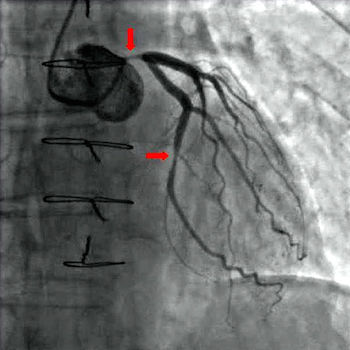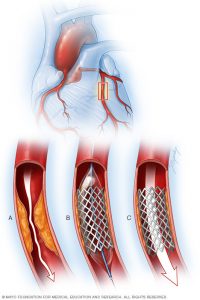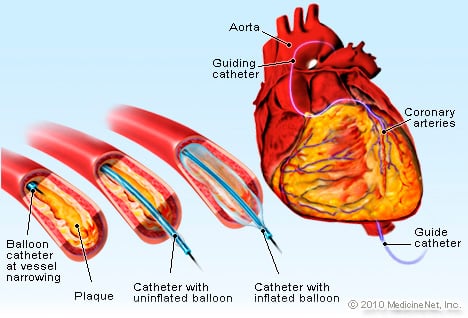Angioplasty





What is Angioplasty?
Angioplasty, also known as balloon angioplasty and percutaneous transluminalangioplasty (PTA), is a minimally invasive, endovascular procedure to widen narrowed or obstructed arteries or veins, typically to treat arterial atherosclerosis.
Balloon: A catheter with a small balloon tip is guided to the narrowing in your artery. Once in place, the balloon is inflated to push the plaque and stretch the artery open to boost blood flow to the heart. Stent: This is a small tube that acts as a scaffold to support the inside your coronary artery.
It is not major surgery. It is done by threading a catheter (thin tube) through a small puncture in a leg or arm artery to the heart. The blocked artery is opened by inflating a tiny balloon in it. With coronary angioplasty, a thin, expandable balloon is inserted into the clogged artery and is inflated.
Procedure
The doctor places a hollow tube in a major artery, allowing him or her to thread long catheters through and access the vessels that are being examined. In this picture, dye that is visible under x-ray has been injected into the left coronary vessel and shows a blockage in the left main coronary artery and left anterior descending coronary artery. Normally a left main blockage will require that a patient undergo coronary artery bypass graft (CABG) surgery.
If doctors find a blockage that can be safely treated with angioplasty, they insert a special catheter with a balloon on the end of it. Before the doctor starts the angioplasty, medications are given to the patient to prevent blood clots from forming on the balloon and stents. The balloon has markers that are visible under x-ray, and the doctor will place it across the blocked area. The balloon is then inflated for several seconds. This may be done multiple times to get the plaque (a fatty buildup that causes the blockage) sufficiently pushed back into the arterial wall. The doctor then uses a different balloon to position a stent, or a small metal mesh device, during the procedure. The doctor may use just a balloon first and then place a stent, or use the stent and balloon together initially. This picture shows the steps involved in the stent placement process.
Stent Placement
Most people who have angioplasty also have a stent placed in their blocked artery during the same procedure. The stent is usually inserted in the artery after it’s widened by the inflated balloon.
The stent supports the walls of your artery to help prevent it from re-narrowing after the angioplasty. The stent looks like a tiny coil of wire mesh.
Here’s what happens:
- The stent, which is collapsed around a balloon at the tip of the catheter, is guided through the artery to the blockage.
- At the blockage, the balloon is inflated and the spring-like stent expands and locks into place inside the artery.
- The stent stays in the artery permanently to hold it open and improve blood flow to your heart. In some cases, more than one stent may be needed to open a blockage.
- Once the stent is in place, the balloon catheter is removed and more images (angiograms) are taken to see how well blood flows through your newly widened artery.
- Finally, the guide catheter is removed, and the procedure is completed.
After your stent placement, you may need prolonged treatment with medications, such as aspirin or clopidogrel (Plavix) to reduce the chance of blood clots forming on the stent.
